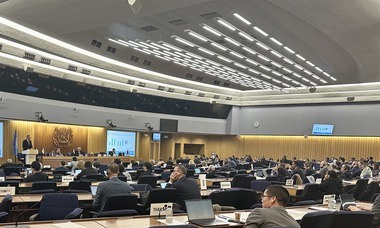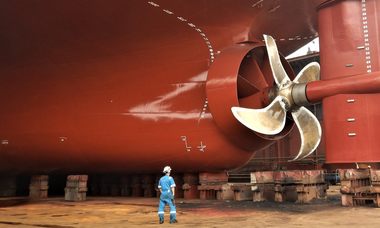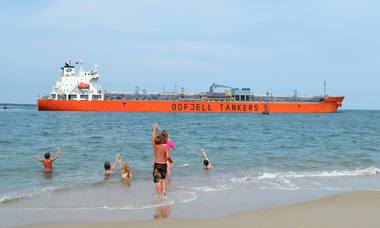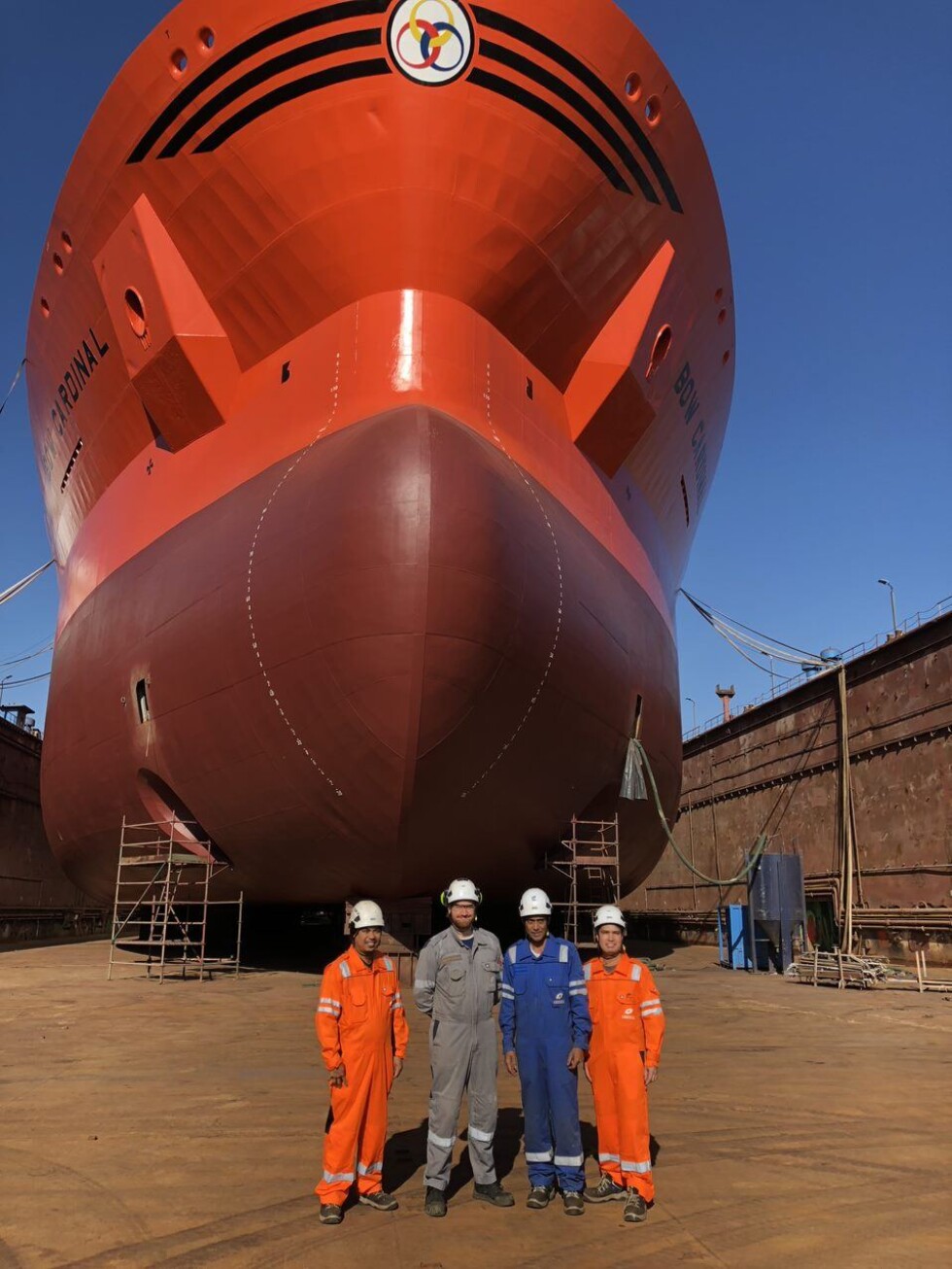
The MPTs gather in front of Bow Cardinal during drydock at the Remontowa Shipbuilding yard in Poland. From left: Eliezer Dino, Christopher Stene, Fiorelan Serenio and Gerome Bucu
Odfjell’s chemical tankers cross the oceans 24 hours a day, seven days a week all year to transport our customers’ products. Each ship experiences wear and tear as it travels around the world in all kinds of weather. This can eventually compromise the structural steel and vital outfitting of its construction.
Mechanical damages, UV- light, wear and tear, contaminants and salt tear the coating. Eventually, corrosion breaks out on the steel, especially on the hull and exposed deck areas, and on structural steel in the ballast tanks. Corrosion processes will accelerate if not attended to, so it is critical to remove it at an early stage and apply the proper barrier coating to protect the assets.
As a result, Odfjell has established dedicated in-house teams to focus solely on stopping corrosion processes and maintaining deck and ballast tank quality through a proactive coating and material protection program.
Traveling expertise
The MPTs were formed in 2022 to assist each vessel's crew with specific maintenance jobs, aiming to reduce off-hire in the short term and total maintenance costs in the long term. Our ships sail a busy and complex schedule worldwide. To avoid interruptions and delays, the Material Protection Teams work while the ships are in full operation, protecting our assets while reducing drydocking time and costs.
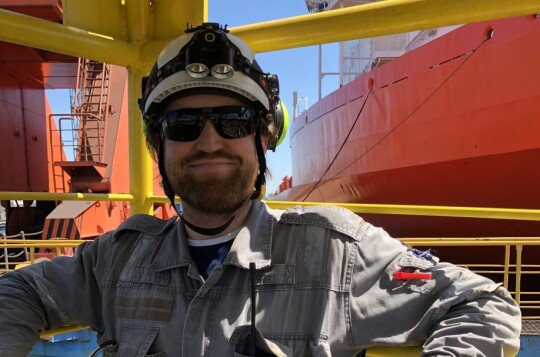
“Our job is to conduct necessary maintenance while the ship is in operation to minimize the number of days needed at the yard. Reducing the number of yard days is a cost-efficient initiative, as vessels don’t generate any revenue when docked.”
Christopher Stene,
Manager Material Protection
The dedicated and experienced experts travel around the world to care for Odfjell-ships in need of maintenance. The work is focused on two key areas, both critical for a ship’s ability to operate safely and efficiently: ballast tank surface treatment and deck maintenance.
- The ballast tank surface treatment removes corrosion and applies new coating with the proper thickness. Keeping these well-maintained prevents build-up of rust and reduction of steel thickness.
- The main objectives for deck maintenance are to maintain structural steel and outfitting, treat corroded areas, and ensure that the anti-corrosive layer and paint maintain the required thickness. The job also includes documentation of areas where repairs or upgrades cannot be completed and need to be added to the list for future docking.
Reducing drydocking time and cost, one maintenance job at the time
Initially, only two MPTs were set up in February 2022, but the effects soon became clear and by September it was decided to increase capacity with a third team. As the leader of these teams, Christopher Stene is responsible for training and coordinating assignments.
“The work conducted by the teams has been of high quality and proven very effective. By having a clear focus on the deck and ballast tank maintenance, we are well underway to reach our cost- and time-saving targets”.
The teams are led by an experienced Bosun. The crewing department at Odfjell’s Manila office hand-picked both the Bosun and the rest of his crew, selecting the personnel best suited for this challenging assignment.
“The concept of creating Material Protection Teams was new to us all. The job they have done is showing impressive results with high quality work through efficiency and safety,” Christopher said.
“The ability to be creative, proactive and push hard to get the job done demonstrate that we have the right people for this job. In a new role as team leader for MPT, there are also new responsibilities with regards to reporting updates, providing necessary documentation and planning the next moves. The team leaders have taken on this responsibility in a very professional way.”
Fiorelan Serenio signed on as Bosun for the first time on board Bow Guardian in 2014. He is now leading one of the teams together with AB Eliezer Dino and AB Gerome Bucu. They have assisted Bow Elm, Bow Cardinal and Bow Spring during 2022.
“It is a wonderful opportunity to join the team and make a positive contribution to the company”, Fiorelan said. “In the start of my new role as Team Leader for an MPT, I did feel a bit of pressure. The new role and tasks were very different from my previous work. But as time went by, everything got smoother, especially with the help of my team.”
Joseph Manuel is Team Leader for the second team. He signed on as Bosun for the first time in 2003 on Bow Chain. He is assisted by AB Jeruel Jeroy and OS Dax Ronquillo. This team has assisted Bow Lind and Bow Saga, with Bow Fagus as their next assignment.

From left: Dax Ronquillo, Jeruel Jeroy, Joseph Manuel and Christopher Stene
“Working on the maintenance is physically tough, however seeing the results of our efforts on all of our vessels makes me happy, because we are aware of the importance of good maintenance and proud of what we have accomplished,” Joseph summarizes.
“From my point of view, Odfjell will benefit from increased investment in the Material Protection Teams as this will result in more well-maintained vessels. Ensuring that maintenance is conducted in the correct way may reduce expenses for the upcoming dry docks, and it will reduce the time and cost for the crew if more maintenance is needed.”
The third, newly established team is headed by Bosun Benjamin Angeles, who first signed on as Bosun on Bow Pioneer in 2016. He will be accompanied by AB John Carlo Roque and OS Alraven Quiambao, as the team heads off for their first assignment on Bow Clipper in late January 2023.
Small actions, big rewards
In the chemical industry, the crew on board has busy days preparing tanks and equipment for loading and unloading operations. It can be difficult to find the time for substantial maintenance, so the MPTs are a much-welcomed resource.
With a sole focus on deck and ballast tank maintenance, the teams build expertise from one ship to the next, while offloading time-consuming tasks from the crew onboard.
The advantages of handling these tasks continuously and proactively are not just limited to cost savings. Apart from improving the quality of paintwork, the decks visually look better, rust is removed and the corrosion process is stopped, which in turn may benefit vetting observations.
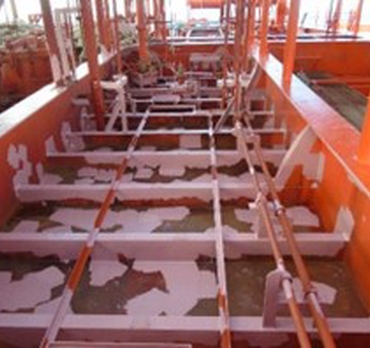
Before and after the coating process
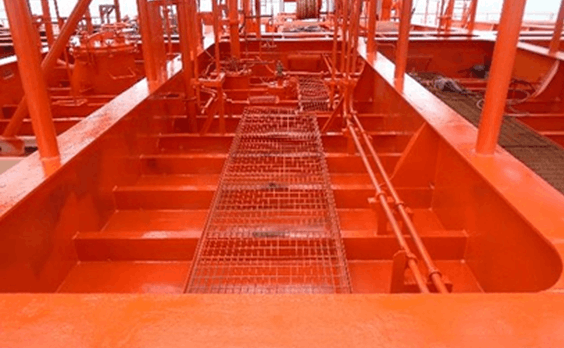
Another benefit is the training onboard. Surface treatment, coating application and the paint’s pot-life are important for a long-lasting result. These items are also quite complex and there are many considerations to be made from rust to finish. The MPTs have the necessary expertise to train the crew onboard so that they can continue taking solid care of the ship’s standard and quality when the MPT has disembarked.
“When we talk about safe and efficient operations, we often think about the major innovations and technology that Odfjell has invested in through the years.
But the seemingly small, behind-the-scenes steps that are taken every day to keep our vessels in good working order are equally important to secure that our ships keep in full operation 24/7/365. In this continuous process, the Materials Protection Teams will play an important role in the years to come by assisting the vessel with any overdue maintenance, and by that improve the condition of the vessel,” Christopher concludes.
Did you know:
- Corrosion and corrosion protection is important to protect a shipowner’s assets. The global cost of corrosion is estimated to be USD 2 505 billion, which is equivalent to 3.4 % of the global GDP (2013). This means that all the world’s assets deteriorate by 3,4 % every year because of corrosion. For Odfjell ships that operate in the most corrosion-aggressive environments this figure is significantly higher, making it extra important to always ensure that our vessels have the best corrosion protection and maintenance to avoid accelerating corrosion.
- The protected surface area of a chemical tanker is quite enormous. The surface area of the ballast tanks on an ordinary MR tanker is about 60,000 m2. This equals about nine football fields. The protected surface area of the rest of the ship is more than three times this area, or about 30 football fields in total. These surfaces are protected with several layers of material protection, typically consisting of two layers of anti-corrosive protection layer and 1-2 layers of topcoat.
